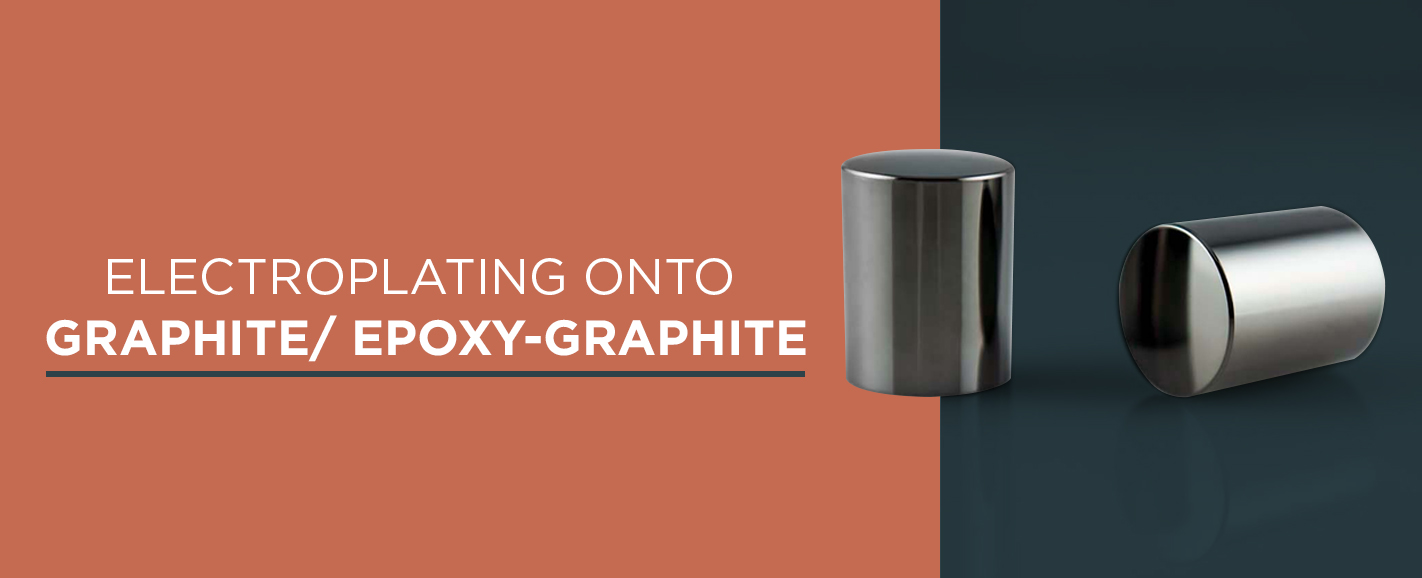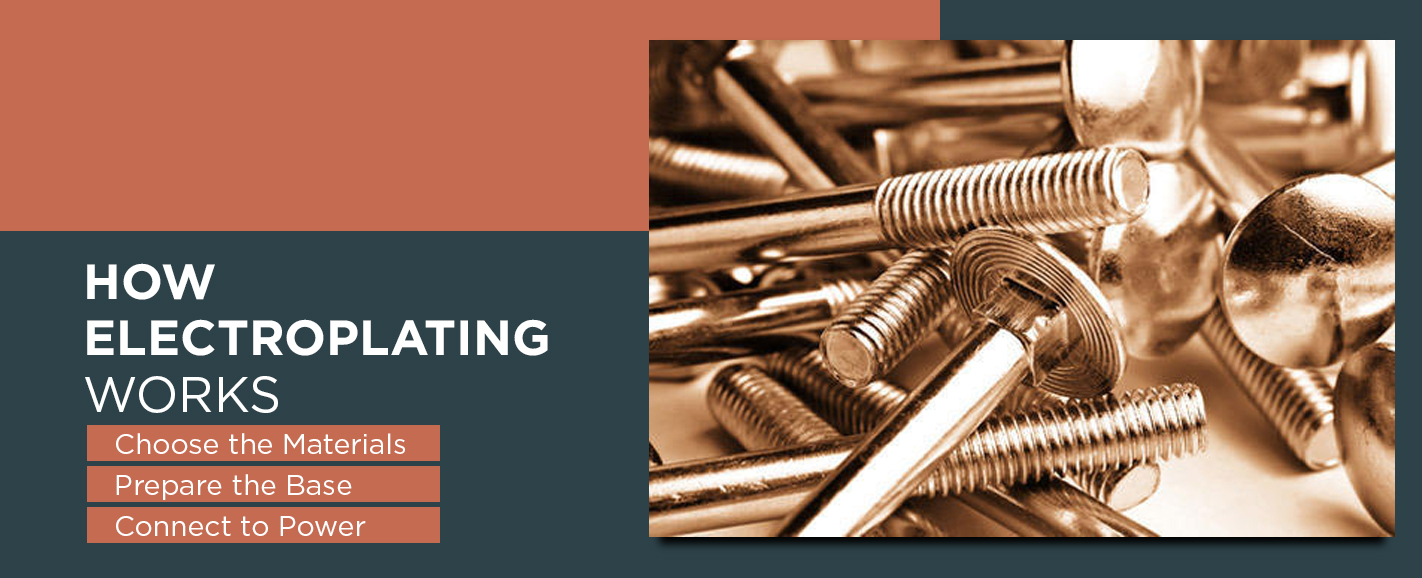
Electroplating onto graphite plays a role in the construction of materials used in a variety of industries. This process has been in use for decades. During the Victorian era, electroplating was even proposed as a means of embalming corpses, according to an article written in 1890 in The Anaconda Standard. Today, most people balk at the idea of preserving bodies, but electroplating remains a popular choice for industries that use the metal-coated material for more practical purposes.
While various metals may be used for the coating and the base, graphite, though not metal, is a popular option for both. This material is just one substrate that has use in electroplating. In some situations, graphite powder allows non-conductive materials to receive electroplating. When electroplating onto a base, the coating metal contributes its positives traits to the core, creating a product that is greater than the sum of its parts.
How Electroplating Differs From Electroless Plating
Electroplating sets itself apart from electroless plating in numerous ways. While some differences lie in the materials used and the specific steps of the processes, the more critical variances appear in the finished products.

Electroless Plating Materials vs. Electroplating
Electroplating requires the base material to have at least a conductive surface. If you're electroplating on something nonconductive, you need a layer of a conductive coating. Graphite powder solves this problem in some cases because it's both conductive and available in a low-cost, easy-to-apply powder. Electroless plating can use anything as the base, from glass to plastic to ceramics.
Request a free quote
For Graphite and Epoxy-Graphite
Electroless Plating Process vs. Electroplating
With electroless plating, a heated chemical bath deposits metal onto the base material. To start electroless plating, the technician must cover the cleaned base material with a catalytic coating to ensure proper deposition of the finish. Once dipped into the catalyst, the base material is ready for the plating bath. Inside the solution, through oxidation, the coating builds on the base material in a thin, even layer.
Electroless Plating Results vs. Electroplating
Unlike electroplating, which occurs very quickly, electroless plating requires time and heating of the plating solution. Additionally, unless the plating solution is thoroughly filtered every time, it can become contaminated quickly. This contamination gives the plating solution a much shorter lifespan than the solution used for electroplating, whereas electroplating solution remains stable through multiple uses.
Finished products from electroless plating may have a more even coating, but the products have a thinner finish. For thicker finishes, the material may require electroplating. In one experiment comparing copper electroplating to copper electroless plating on plastics, the electroless product had a much thinner finish — five micrometers — compared to 38 micrometers for the electroplated piece. Tensile strength for the electroplated part measured higher than the strength of the electroless plating part.
Compared to electroless plating, electroplating costs less, yields a thicker finish and produces a stronger product. Some problems inherent to electroless plating of graphite come with using copper to coat the base. One study showed that copper coating did not completely cover the pores in the base material. Despite the copper coating, the graphite could still absorb liquids. This phenomenon did not happen with electroless nickel plating of the base, nor did it occur when copper covered the nickel-coated graphite.
For these reasons, electroplating is a highly popular option for use on a variety of materials. While in some instances, electroplating has delays in the process — such as when base materials require the additional step of coating with graphite powder before plating — it continues to be a preferred choice for many plating projects.

How Electroplating Works
Electroplating has its origins in chemistry. You don’t need to be a chemist to understand the process, however, which consists of three main steps. To electroplate, you need a conductive surface, electricity and the metal used for coating. With the right materials and preparation, a little power creates a metal coating on the base material in an uncomplicated process.
1. Choose the Materials
With electroplating, you need metal to deposit the finish and a base material. The base material must have a conductive surface, regardless of the makeup of the material. For products such as plastic, a coating of graphite powder creates the needed conductive surface. For coating graphite, the base material itself has adequate conductivity. Graphite epoxy or composite, however, will require a coating because the epoxy form of graphite is not as good of a conductor as carbon fibers and pure graphite.
The finishing metal will dictate the composition of the solution used. For proper electroplating, the base metal and finishing metal are submerged in an electrolyte solution. This solution must include ions of the finishing metal. If you want to gold-plate graphite, for instance, the bath must have gold in it in addition to the gold finishing metal.
2. Prepare the Base
As with all finishing processes, you must ensure the base is completely clean before the coating process. Any dirt could hold atoms of the finishing metal, which fall off, creating holes in the coating. For an even finish, the cleanliness of the base material is vital. Cleaning may involve submerging the base into a strong acid or base solution. Once cleaned and dried, the core is ready for the process.
3. Connect to Power
The electroplating technician connects a length of the finishing metal to a positive electrode, also known as an anode. He then submerges it into the electrolyte solution. For the cleaned base metal, it gets attached to a negative electrode and placed into the same bath. Here's where the magic happens.
An electrical current passes into the finishing metal, which breaks off ions of the metal into the electrolyte solution. The negatively charged base metal collects these ions in an even coating. In just a few minutes, the base material has a metallic finish.
How Would Victorians Electroplate Bodies?
Since electroplating has to occur on a conductive surface, you may be wondering how the Victorians proposed to electroplate bodies. According to a 1934 patent, the process would happen comparably to plating plastics today. After embalming, the corpse would be sprayed with a metallic spray to coat every surface before wrapping it in copper and submerging it into an electrolysis bath. The copper from the wire wrapped around the body would deposit a layer of copper onto the body, electroplating it with a bright exterior.
Uses and Applications
While graphite has numerous methods on its own, electroplating it increases its functions for multiple industries. Coating graphite with another metal enhances its strength and durability. To fully appreciate the many uses of plated graphite in various sectors, you have to understand the essential attributes of graphite.
About Graphite
You may already be aware of graphite's most well-known use as the erroneously named pencil lead. Graphite is one of three common forms of carbon, which also include diamond and amorphous carbon. As varied as these forms are, all are made of the same element, carbon, which illustrates the element's versatility.
This material naturally acts as a lubricant due to its chemical structure. Hexagonal crystals layer atop each other with weak bonds. If these bonds break, which happens frequently and with little force, the layers slip over each other, giving graphite its lubricating nature.
The essential characteristic of graphite that's important for electroplating is its conductivity. Most conductive materials are metals, but graphite is not. Its conductivity allows graphite to be used as base materials for electroplating. Additionally, the powder form can be used in coating nonconductive materials that need electroplating. When in an epoxy, however, the material is not a good conductor.
Uses for Electroplated Graphite
Electroplated graphite has an improved appearance and strength compared to uncoated forms. Numerous industries have found uses for electroplated graphite, including the following three.
1. Marine Applications
Boat construction requires considerations not typically seen in building land-based crafts. For ease of fitting pieces together and allowing hulls to slide through water, adding graphite powder to epoxy is useful. While the graphite epoxy lacks the conductivity of pure graphite, even graphite epoxy can pose a danger on a boat exposed to potential lightning hazards. In such instances, a coating of a nonconductive resin could add enhanced protection.
Though mixing graphite with epoxy for surface coating is one use of it in the marine industry, it's far from the only one. Electroplating on nonconductive surfaces may require a graphite layer to accept the finish. The metal coating process may also help extend the life of boat engine parts. For worn-out parts without ready replacement, recoating them through electrolysis could help slightly lengthen their lives until you can replace them.
Other components aboard a ship may also be electroplated. Because cars and boats share many similar elements, such as engines and trim, some parts that cars and boats share may also be electroplated. Aboard a vessel, these metal coated parts could include mirrored glass or decorative embellishments. The same way you can restore these parts on a car through electroplating them again, electroplating could rejuvenate these boat parts to their original luster.
2. Aerospace Uses
The aerospace industry has always demanded innovation. This need for novel products has remained true in the electroplating technology used by NASA. Extreme conditions experienced by space flight vehicles and satellites require special coatings to prevent corrosion. On the equipment used for Gemini mission, gold coatings improved heat control. The helmets used by the earliest astronauts were simple plastic head coverings with a gold exterior to protect against UV rays.
Currently, the Materials International Space Station Experiment (MISSE) is searching for improved finishes for the future of space flight. This study examines how coatings survive in the harsh environment of the International Space Station and how prone they are to corrosion. Results from this study will help businesses, the Department of Defense and NASA to develop better, longer lasting vehicles for low-Earth orbit.
Such a project is necessary after the findings of the Long Duration Exposure Facility, which orbited the planet for five years until 1990. Many coatings with durable features on Earth proved to erode quickly in space. Plastics and certain metals were especially prone to the corrosive effects of atomic oxygen. This harsh environment increases the need for specialized finishes for spacecraft now and in the future.
3. Medical Applications
Electroplating onto graphite powder frequently happens when creating medical supplies, such as those with glass interiors when electroplating glass or ceramics, a layer of graphite powder over the base allows for adhesion of the finishing metal. Finishing ceramic or glass pieces with a metal coating can add soldering points to the part or increase the strength and longevity of the device.
One way to create microneedles is by using electroplating atop a sacrificed layer. The metal plating atop the base layer establishes the structure of the microneedle. Then, the base dissolves, leaving behind the metal coating. This process effectively creates the tiny, hollow needles required for reaching just into the second layer of skin while affecting the nerves as little as possible to minimize pain and infections.
Sharretts Plating Company: The Best Choice for Your Graphite Plating Needs
You need plating services. At SPC, we offer electroplating onto graphite among many other services. Combining our services has given our customers the ideal product that perfectly combines strength, durability and conductivity for whatever their needs.

We electroplate onto graphite using a combination of several methods. For instance, we offer 3D printing and can print with graphite and graphene. Then, we'll use electroplating onto the graphite to create the finished product.
Another use of plating graphite occurs when electroplating nonconductive materials. At SPC, we employ a unique process for plating glass by treating the material with graphite powder to prepare it for the electroplating process. Many in biotechnology fields require plated glass for their labs and use this service.
Graphite also appears as a component of coatings, especially of medical devices and implants. Graphite-like carbon can increase the lifespan of internal devices, such as hip replacements, due to its durability and flexibility. Scientists are also trying to overcome the chipping factor of diamond-like carbon, which is a carbon-based exterior. While long-lasting and hard, it tends to chip. Future medical professionals may incorporate this graphite-bond-containing coating into devices. Finishing with graphite is another way we use this material in our processes.
At SPC, we have multiple services for whatever your needs may be. We can print materials from scratch using 3D printing or coat existing products to enhance durability. Turn to us for all your plating needs, especially if you require products, like glass, that have been notoriously difficult to plate. We have the technology and materials available to create plated products and more for your company.
Contact Us Today
Electroplating has many uses across multiple industries. You do not have to be in one of the sectors listed above, though, to take advantage of graphite. Electroplating onto graphite is one of the many services we offer at SPC. If you would like to learn more about the plating process or find out how we can help, contact us online or call us at (717) 767-6702. We strive to improve each of our services continually.

Discover how we can help your graphite plating needs by getting in touch with us today.
Additional Resources:
Contact us right away to speak with a representative and request your free, no-obligation quote.
LEARN WHAT OUR MANY SATISFIED CUSTOMERS HAVE TO SAY ABOUT Us
"I would like to thank you for the help you have provided us in developing an electroless nickel plating technique on an unusual substrate. The sample platings you provided show that we should be able to reach our goals. I especially appreciate your willingness to take on an unusual job, with the uncertainties that that entails...We are looking forward to working with you in the future on our plating needs."
– Robert K.



